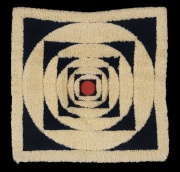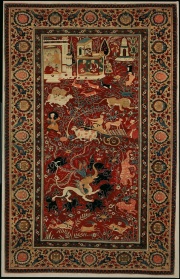Difference between revisions of "Pile"
Jump to navigation
Jump to search
| Line 2: | Line 2: | ||
== Description == | == Description == | ||
[[File:93.1480-SC7829.jpg|thumb|Pictorial carpet<br>MFA# 93.1480]] | [[File:93.1480-SC7829.jpg|thumb|Pictorial carpet<br>MFA# 93.1480]] | ||
| − | A plush fabric effect produced by cut or uncut loops of [[yarn|yarn]]. | + | A plush fabric effect produced by cut or uncut loops of [[yarn|yarn]]. Pile weave uses two or more warp threads with one filling (warp pile weave) or two filling threads with one warp (weft pile weave). The extra thread forms loops sometime by going over wires raised above the plane of the fabric. Plain wires can be used to leave the pile uncut and wires with a razor-like edge are used to cut the pile. |
| + | |||
| + | Pile fabrics are warm and soft but readily collect dirt. Examples of uncut pile fabrics are Turkish toweling, [[terrycloth|terrycloth]], and some carpets. Examples of cut pile fabrics are [[velvet|velvet]], [[velveteen|velveteen]], [[corduroy|corduroy]], [[chenille|chenille]], and Axminster rugs. | ||
== Synonyms and Related Terms == | == Synonyms and Related Terms == | ||
| − | pelo (Esp.) | + | pile weave; pelo (Esp.) |
==Resources and Citations== | ==Resources and Citations== | ||
| + | * M. Doerner, ''The Materials of the Artist'', Harcourt, Brace & Co., 1934 | ||
| + | |||
* Hoechst Celanese Corporation, ''Dictionary of Fiber & Textile Technology'' (older version called Man-made Fiber and Textile Dictionary, 1965), Hoechst Celanese Corporation, Charlotte NC, 1990 | * Hoechst Celanese Corporation, ''Dictionary of Fiber & Textile Technology'' (older version called Man-made Fiber and Textile Dictionary, 1965), Hoechst Celanese Corporation, Charlotte NC, 1990 | ||
| Line 17: | Line 21: | ||
* ''The American Heritage Dictionary'' or ''Encarta'', via Microsoft Bookshelf 98, Microsoft Corp., 1998 | * ''The American Heritage Dictionary'' or ''Encarta'', via Microsoft Bookshelf 98, Microsoft Corp., 1998 | ||
| + | * Art and Architecture Thesaurus Online, http://www.getty.edu/research/tools/vocabulary/aat/, J. Paul Getty Trust, Los Angeles, 2000 | ||
| + | * Edward Reich, Carlton J. Siegler, ''Consumer Goods: How to Know and Use Them'', American Book Company, New York City, 1937 | ||
[[Category:Materials database]] | [[Category:Materials database]] | ||
Latest revision as of 09:56, 22 October 2022
Description
A plush fabric effect produced by cut or uncut loops of Yarn. Pile weave uses two or more warp threads with one filling (warp pile weave) or two filling threads with one warp (weft pile weave). The extra thread forms loops sometime by going over wires raised above the plane of the fabric. Plain wires can be used to leave the pile uncut and wires with a razor-like edge are used to cut the pile.
Pile fabrics are warm and soft but readily collect dirt. Examples of uncut pile fabrics are Turkish toweling, Terrycloth, and some carpets. Examples of cut pile fabrics are Velvet, Velveteen, Corduroy, Chenille, and Axminster rugs.
Synonyms and Related Terms
pile weave; pelo (Esp.)
Resources and Citations
- M. Doerner, The Materials of the Artist, Harcourt, Brace & Co., 1934
- Hoechst Celanese Corporation, Dictionary of Fiber & Textile Technology (older version called Man-made Fiber and Textile Dictionary, 1965), Hoechst Celanese Corporation, Charlotte NC, 1990
- Rosalie Rosso King, Textile Identification, Conservation, and Preservation, Noyes Publications, Park Ridge, NJ, 1985
- Random House, Webster's Encyclopedic Unabridged Dictionary of the English Language, Grammercy Book, New York, 1997
- The American Heritage Dictionary or Encarta, via Microsoft Bookshelf 98, Microsoft Corp., 1998
- Art and Architecture Thesaurus Online, http://www.getty.edu/research/tools/vocabulary/aat/, J. Paul Getty Trust, Los Angeles, 2000
- Edward Reich, Carlton J. Siegler, Consumer Goods: How to Know and Use Them, American Book Company, New York City, 1937

